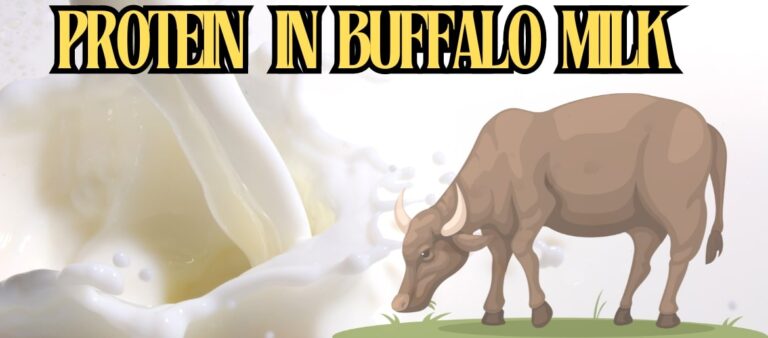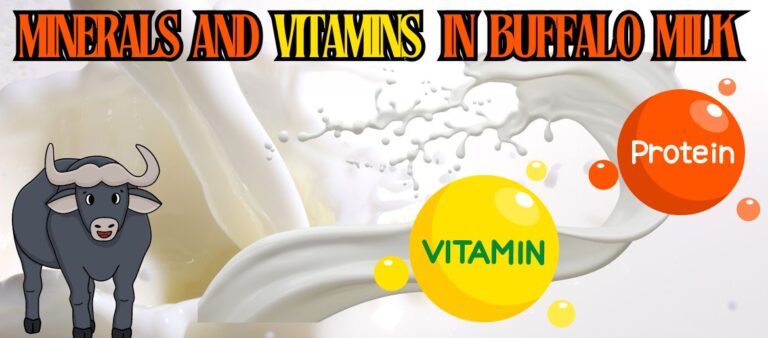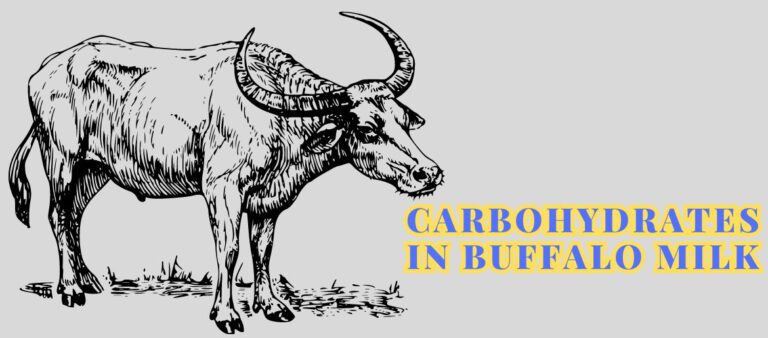When exploring buffalo milk’s nutritional content, one question often comes to mind: How much protein does it contain? Buffalo milk, known for its rich nutrients, is an excellent protein source. Let’s explore its protein content and discover why it’s such a valuable addition to our diet.
Background
Buffalo milk comes primarily from water buffaloes (Bubalus bubalis). India and Pakistan lead in buffalo milk production, contributing around 80% of the global supply. This milk is packed with protein, fat, vitamins, and minerals, making it a key ingredient in various dairy products.
How Much Protein in Buffalo Milk? (Quantity)
Buffalo milk is renowned for its rich protein content, making it a valuable addition to the diet. Here’s a comprehensive breakdown of the protein content in buffalo milk:
| Serving Size | Protein Content (Approx.) |
| 100 ml | 3.75 grams |
| 250 ml | 9.375 grams |
| 300 ml | 11.25 grams |
| 500 ml | 18.75 grams |
| 1 litre | 37.5 grams |
- Buffalo milk typically contains around 3.75 grams of protein per 100 grams.
- The protein content varies based on serving size, with larger servings containing higher amounts of protein.
- A 250 ml glass of buffalo milk contains approximately 10 grams of protein.
- A cup (approximately 300 ml) of buffalo milk contains about 11.25 grams of protein.
- Consuming 500 ml of buffalo milk provides approximately 18.75 grams of protein.
- A liter of buffalo milk offers approximately 37.5 grams of protein for those seeking a higher protein intake.
- Buffalo milk is a high-protein dairy product containing protein and essential nutrients such as calcium, magnesium, and potassium.
- Compared to whole cow milk, buffalo milk has higher protein, fat, and lactose content.
- The primary protein in buffalo milk is casein, which constitutes about 89% of its total protein content.
Protein Quality in Buffalo Milk
Buffalo milk protein is top-notch, offering all nine essential amino acids our bodies need for optimal functioning. These amino acids are crucial in muscle repair, growth, and immune function.
Composition
Buffalo milk’s protein mainly consists of two types: casein and whey. Casein makes up 80% to 89% of the total protein, while whey accounts for 11% to 20%.
Casein
Casein is the star protein in buffalo milk. It’s a slow-digesting protein that ensures a steady release of amino acids into the bloodstream. This gradual release supports muscle building and repair. It helps keep you full longer, which is excellent for appetite control.
Whey Protein
Conversely, whey protein in buffalo milk is fast-digesting. It absorbs quickly, providing immediate amino acids for energy and efficient muscle recovery. Whey is also an excellent source of essential amino acids, vital for muscle tissue repair and growth.
Synergistic Benefits
Combining casein and whey in buffalo milk offers synergistic benefits. This mix provides a balanced spectrum of protein digestion rates, catering to different nutritional needs. Buffalo milk protein covers you whether you need sustained energy release or quick muscle recovery.
Buffalo milk protein is a comprehensive source that promotes muscle health, satiety, and overall well-being. Its rich amino acid profile and balanced composition make it a valuable addition to a healthy diet, supporting various nutritional and fitness goals.
Buffalo Milk vs. Cow’s Milk
Several factors stand out when comparing buffalo milk to cow’s milk, including nutritional composition, taste, uses, and availability. Buffalo milk is richer in fat and calcium, offering a creamier texture and a slightly sweeter taste than cow’s milk. It also has higher protein levels and essential vitamins and minerals like phosphorus, magnesium, and vitamin A. Both buffalo and cow milk offer similar levels of vitamin B12, ranging from 2–7 µg/L.
However, cow’s milk is more widely available globally. It provides a neutral taste and thinner Texture, which makes it suitable for various culinary applications. While buffalo milk excels in traditional dairy products like mozzarella cheese, cow’s milk is versatile in beverages, cooking, and baking.
Despite buffalo milk’s benefits, cow’s milk remains the preferred choice for many due to its accessibility, lower cost, and ease of digestion.
Comparison Table
| Nutrients | Buffalo Milk (per 1 cup) | Cow’s Milk (per 1 cup) |
| Protein | Around 9g | Around 8g |
| Fat | Higher fat content | Varies depending on type |
| Lactose | Generally higher | Varies |
| Vitamins and Minerals | Rich in phosphorus, magnesium, vitamin A | – |
| Taste and Texture | Sweeter, creamier texture | Neutral, thinner texture |
| Uses | Mozzarella cheese, yogurts, ice creams | Various culinary applications, beverages |
| Digestion | Slightly less digestible | More easily digestible |
| Availability | Less readily available | Widely available |
| Cost | Can be more expensive | Generally more affordable |
While buffalo milk stands out for its richness and nutritional benefits, cow’s milk remains the more versatile and accessible option for most consumers. Whether enjoying buffalo milk’s creamy Texture in traditional dairy products or opting for the convenience and affordability of cow’s milk, both offer valuable nutrients to support a balanced diet and diverse culinary preferences. Ultimately, the choice between buffalo and cow’s milk depends on individual taste preferences, dietary needs, and availability.
Benefits of Buffalo Milk Protein
Muscle Building and Repair
Buffalo milk protein is a powerhouse for muscle health, rich in essential amino acids crucial for muscle growth, repair, and growth factors. Leucine, abundant in buffalo milk protein, acts as a catalyst for stimulating muscle protein synthesis. Integrating buffalo milk protein into your routine can accelerate muscle recovery, enhance muscle strength, and promote growth factors.
Improved Satiety
Buffalo milk protein does more than support muscles—it helps keep hunger at bay. Thanks to its satiating effect, consuming buffalo milk or its derivatives can leave you feeling fuller for extended periods. By reducing hunger pangs, buffalo milk protein aids in managing appetite and curbing excessive snacking, contributing to weight management.
Bone Health
Adding buffalo milk can significantly benefit bone health. It’s rich in calcium, a vital bone density and strength nutrient. It helps fortify your skeletal structure and fend off conditions like osteoporosis. Casein-derived peptides in buffalo milk further enhance calcium absorption, potentially reducing the risk of bone-related ailments.
Buffalo milk protein is a multifaceted ally in promoting overall well-being. It facilitates muscle repair and growth, helps control appetite, and supports bone health. By incorporating buffalo milk protein into your diet, you can harness its numerous benefits for enhanced physical fitness and vitality. However, it’s essential to maintain a balanced diet and consult with a healthcare professional, especially if you have existing health concerns, before making significant dietary changes.
Conclusion
The protein content in buffalo milk highlights its importance in promoting muscle health, satiety, and bone strength. With its decadent array of amino acids and balanced protein composition, buffalo milk is a versatile dietary staple for various nutritional needs and fitness goals. Whether you’re seeking post-workout recovery support or appetite control, incorporating buffalo milk protein into your diet can offer numerous benefits for overall vitality and physical wellness.
RELATED POSTS
- Learn how enzymes in buffalo milk contribute to digestion and health.
- Discover the role of carbohydrates in buffalo milk and their health benefits.
- Understand the importance of immunoglobulins in buffalo milk for immune support.
- WELLHEALTHORGANIC BUFFALO MILK TAG: PURE, HEALTHY, ETHICAL.
- HEALTH BENEFITS OF FATTY ACIDS IN BUFFALO MILK.






